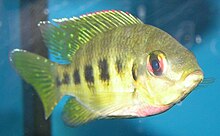
An introduced species is an living thing that is not native to a given place. It has been brought there by human activities. People may have brought the living thing by accident or on purpose. The introduced species can cause problems when it becomes a pest in the new place. It may damage the ecosystem of the new place. This damage can be to other animals, plants and also human activity.
One introduced species is the tilapia. It is a fish that comes from warm freshwater areas of Africa, North and South America, India and Sri Lanka.[1] It has been taken to other areas because it is good for fish farming, and it also is a good pet for an aquarium. When the fish is released into other parts of the world, it quickly takes over from the native fish. It can do this because it breeds quickly, eats all the available food, and eats the eggs and babies of native fish. This can cause the water to become so muddy, that the native fish cannot live. Tilapia has been listed as one of the 100 worst introduced species.[1] A person owning or selling one in Australia could be fined up to AU$11,000.[1]
An introduced species may have a great advantage over the native species. They usually come in without the predators and parasites which they suffer in their old environment. This allows them to have young quickly. Fire ants and Africanized honeybees became invasive insects in the 20th century.